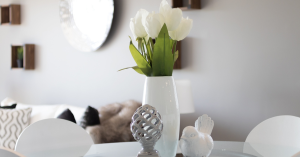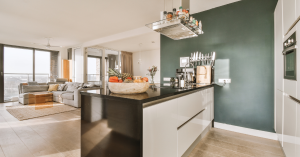As a professional painter, I have seen firsthand the transformative power of paint in home staging. But is there a difference between painting your home to sell and painting it to decorate for your own enjoyment? Yes there is. When we decorate our homes, we do so for ourselves and so we infuse them with our personality. The colours on the walls, the style of our furniture, the photos and art we display—all these elements reflect who we are. Home decorating is about creating a space that feels uniquely ours, a sanctuary that tells our story.
However, when it comes to paint in home staging, the approach needs to shift from personalization to de-personalization. Staging is about creating an environment that appeals to a broad range of potential buyers. It uses visual psychology to highlight a home’s possibilities, creating that all-important “wow factor” that makes a dynamic first impression. In today’s market, where many buyers start their home search online, the visual impact of a staged home cannot be overstated.
As a painter, my role in the staging process is crucial. Year in and year out, no matter what is trending in home decor, paint in home staging continues to be the most cost-effective way to transform a space and get the biggest return on your investment. It can make a room look larger, brighter, and more inviting. But the key to successful staging is choosing the right colours—neutral tones that can appeal to the widest audience.
The Power of Neutral Colours

When staging a home, the goal is to create a blank canvas where potential buyers can envision their own lives. This often means painting over bold, personalized colours with neutral tones. Shades of white, beige, and gray are popular choices because they create a sense of calm and can make spaces appear larger and more open. These colours also provide a backdrop that allows buyers to project their own ideas onto the space.
From a painter’s perspective, achieving the perfect neutral palette is both an art and a science. It involves selecting the right shade and finish for each room. For instance, a matte finish can hide imperfections and create a sophisticated look, while a satin finish adds a subtle sheen that reflects light and makes rooms feel brighter.
Highlighting Architectural Features

Another aspect of staging that benefits from a painter’s expertise is the highlighting of architectural features. Crown molding, trim, and built-in shelving can be accentuated with contrasting colours or finishes. This technique draws the eye to these features and adds character to the home without overwhelming potential buyers with too much personality.
Painting can also be used to create focal points in key areas of the home. An accent wall in a living room or a pop of colour on a front door can make a memorable impression and set a home apart from others on the market. However, it’s important to use these techniques sparingly and strategically, always keeping in mind the goal of appealing to a wide audience.
Preparing the Home for Sale

Staging goes beyond just painting, of course. It involves decluttering, repositioning furniture, and adjusting lighting. But painting is often one of the first steps in the process. A fresh coat of paint can make a home look clean, well-maintained, and move-in ready.
As a painter, I often work closely with real estate agents and home stagers to create a cohesive look for the home. This collaborative approach ensures that the colours and finishes chosen enhance the overall staging strategy. It also means that any necessary repairs or touch-ups are addressed before potential buyers walk through the door.
Creating an Emotional Connection

The ultimate goal of home staging is to help potential buyers envision the property as their home—a place where they can see themselves living, entertaining, and even working. This emotional connection is what turns a casual viewer into a serious buyer.
Paint in home staging plays a key role in creating this connection. The right colours can evoke feelings of warmth, comfort, and happiness. They can make spaces feel inviting and homely. By depersonalizing the space and using neutral colours, we help buyers imagine their own lives unfolding in the home.
The Impact of Online Listings

In today’s digital age, the importance of staging extends beyond in-person showings. Many buyers first encounter a home through online listings, where high-quality photos and virtual tours are crucial. Here, the work of a painter is especially important. Neutral colours photograph well and make rooms look bright and spacious. They help create a clean, cohesive look that attracts potential buyers.
From the perspective of a professional painter and a team with nearly 100 combined years of experience, paint in home staging is about more than just applying a new coat of paint. It’s about transforming a space to appeal to the widest possible audience, highlighting a home’s strengths, and creating an environment where potential buyers can imagine their future. By choosing the right colours and finishes, and working collaboratively with real estate professionals, painters play a vital role in the home staging process.
If you have questions about painting your home – whether it’s for your own enjoyment or to help you sell it faster and for money, we’d be happy to talk.


